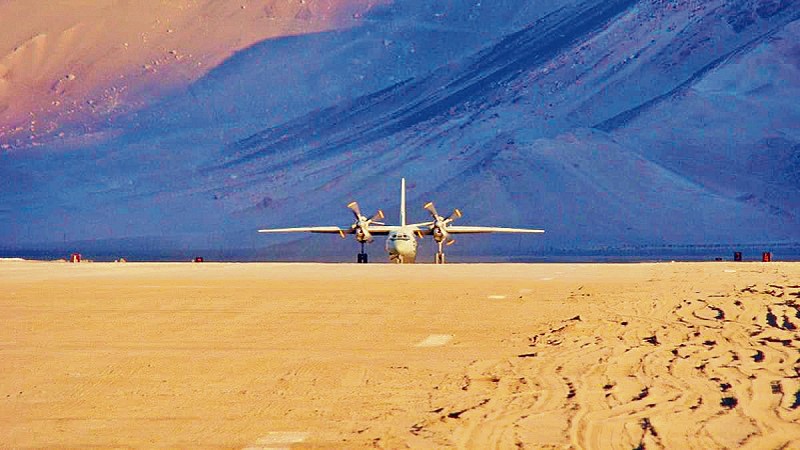Rajnath lays foundation stone, says will prove to be a game-changer for forces

Ajay Banerjee
New Delhi, September 12
Defence Minister Rajnath Singh today laid the foundation stone of Indian Air Force’s fourth full-fledged operating base in Ladakh, the Union Territory that shares the Line of Actual Control (LAC) with China and the Line of Control (LoC) with Pakistan.
Fortifying China frontier
- Nyoma’s existing mud-paved runway is being used by helicopters and special operations planes such as C-130J
- It will have paved runway for fighter jet base that can launch and recover planes and carry out minor maintenance jobs
- IAF currently has an operational base at Leh and full-fledged bases at Kargil and Thoise (base of Siachen)
- It also has a semi-paved strip at Daulat Beg Oldie and two other mud-paved landing grounds at Chushul and Fukche
The IAF currently has an operational base at Leh and full-fledged bases at Kargil and Thoise (base of Siachen). The fourth one will be at Nyoma on the banks of the Indus, around 180 km south-east of Leh at an altitude of 13,700 feet.
“This airfield, which will be one of the world’s highest, will prove to be a game-changer for the armed forces,” said the minister.
Defence Minister unveils 90 BRO projects
Rajnath unveiled 90 BRO projects, costing Rs 2,941 cr, across 10 states and UTs at an event to inaugurate 422.9 m Devak Bridge on the Bishnah-Kaulpur-Phulpur Road in Samba, Jammu. He also inaugurated 500m Nechiphu Tunnel on the Balipara-Charduar-Tawang Road in Arunachal.
Apart from these, the IAF has a semi-paved strip at Daulat Beg Oldie (DBO) in sub-sector north of Ladakh and two other mud-paved landing grounds at Chushul and Fukche. “History of the conflict with China-1962”, released for “restricted” circulation by the Ministry of Defence (MoD) in March 1993, says AN-12 planes flew from Chandigarh and landed AMX tanks at Chushul in October 1962. Transport planes Fairchild C-119G, known as ‘Packet’ and stationed at Jammu and Pathankot, also flew sorties to Chushul.

Since then, China has built infrastructure on its side of the LAC and both Chushul and Fukche, being close to the LAC, are within the eyesight of Chinese observers, rendering these useful for emergency purposes only.
Nyoma is a natural flat area and is being used by helicopters and special operations planes such as C-130J that can land on the existing mud-paved runway.
The Border Roads Organisation (BRO), under the Ministry of Defence, will complete the Rs 214 crore project to have full-fledged paved runway for a fighter jet base that can launch and recover planes and also carry out minor maintenance jobs. The BRO has been tasked with completing the project in two years.
The site is spread over 1,235 acres, where a 2.7-km runway with allied military infrastructure will come up.
After the military stand-off with China along the LAC in April 2020 and the subsequent clashes at Galwan in eastern Ladakh in June 2020, a major air effort was launched using these existing bases of the IAF.
Over 68,000 Army soldiers, around 90 tanks, nearly 330 BMP infantry combat vehicles, radar systems, artillery guns and other equipment were airlifted by the IAF after the clashes as part of the rapid deployment along the LAC.
The IAF deployed its Su-30 MKI and Jaguar jets for round-the-clock surveillance and intelligence gathering on enemy build-up and added Rafale and MiG 29 jets.




































































